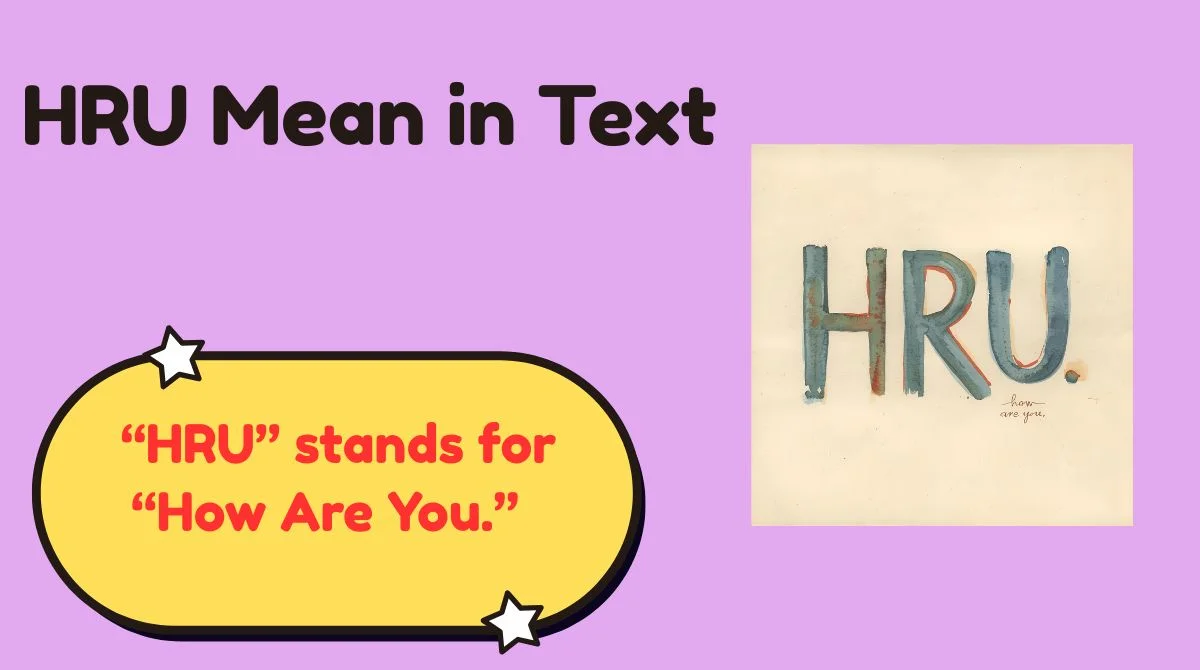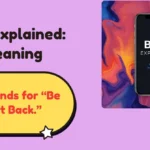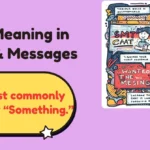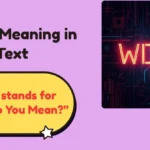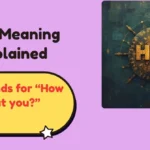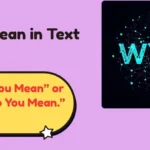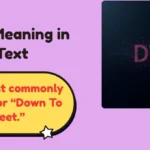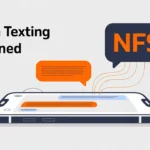Have you ever opened your phone to see a message that just says, “HRU?” and paused for a moment, wondering what it means? You’re not alone.
In the fast-moving world of texting, acronyms like “HRU” have become second nature for many—but not everyone knows exactly when, how, or why to use them.
In this guide, we’ll unpack everything about “HRU” — what it means in text, where it came from, when to use it, and how to respond naturally. You’ll also find real-life examples, tone tips, and even alternatives for different moods or relationships.
Let’s decode it together.
What Does “HRU” Mean in Text?
The texting acronym “HRU” stands for “How Are You.” It’s a simple, shortened version used in digital conversations to save time and space.
Think of it as the quick, casual cousin of “How are you?” — something you’d say when messaging a friend, crush, or acquaintance online.
| Acronym | Meaning | Common Platforms | Tone |
|---|---|---|---|
| HRU | How Are You | Snapchat, Instagram DMs, WhatsApp, Facebook Messenger | Friendly, Informal, Quick |
You’ll mostly see “HRU” in casual chats—especially among younger generations or people who text frequently. It’s rarely used in emails or professional conversations since it feels too relaxed for formal settings.
Here’s a simple example:
Text: “Hey! HRU?”
Translation: “Hey! How are you?”
Origin & Popularity of “HRU”
Texting language has evolved dramatically since the early 2000s. Back when SMS messages were limited to 160 characters, people started shortening common phrases to fit more words per message. That’s when acronyms like LOL, BRB, and HRU began to take off.
As messaging apps like WhatsApp, Snapchat, and Instagram became more popular, abbreviations carried over because they saved time and felt natural in fast digital conversations.
Today, “HRU” remains common among Gen Z and Millennials, while older generations might still prefer typing the full “How are you?”
📊 Fun Fact: According to linguistic studies on texting culture, acronyms like “HRU” can reduce message length by 30% while maintaining clarity when both sender and receiver understand the slang.
Why Understanding Texting Acronyms Like “HRU” Matters
Texting acronyms might seem trivial, but understanding them matters more than you’d think—especially in cross-generational or multicultural communication.
Here’s why:
- Avoid Miscommunication: Not everyone interprets abbreviations the same way.
- Read Emotional Tone: A short “HRU” can sound friendly or detached, depending on context.
- Stay Socially Updated: Knowing slang helps you connect better, especially online.
- Decode Conversations Fast: Understanding acronyms saves time and makes chatting smoother.
🗣 Quote to Remember:
“Language evolves with culture, and texting is today’s most living form of language.”
By understanding terms like “HRU,” you not only keep up—you also communicate more naturally in the modern digital space.
When Should You Use “HRU”?
Timing and tone are everything in digital communication. Using “HRU” in the right context makes your message sound natural; using it in the wrong one can feel careless or even rude.
✅ Use “HRU” When:
- You’re texting friends or acquaintances casually.
- You’re starting a light chat or check-in.
- You want to sound informal and approachable.
Example:
“Hey man, long time no talk! HRU?”
🚫 Avoid Using “HRU” When:
- Messaging your boss or a client.
- Writing formal or professional emails.
- Speaking with someone who may not understand texting abbreviations.
Example:
❌ “Dear Mr. Allen, HRU today?” (Too informal!)
✅ “Dear Mr. Allen, I hope you’re doing well.” (Appropriate tone)
How to Respond to “HRU”: 15 Real-Life Reply Examples
Replying to “HRU” can be as short or expressive as you like. The key is tone-matching — responding in a way that fits your relationship with the person texting you.
Here are practical examples for every kind of situation:
💬 Friendly Replies
- “Doing great! You?”
- “Pretty good, just chilling at home.”
- “I’m fine, thanks for asking 😄.”
😍 Flirty Replies
- “Better now that you texted 😉.”
- “I’d be better if we were hanging out.”
- “Trying to impress you, how am I doing?”
⚡ Busy but Polite Replies
- “Swamped with work, but all good.”
- “Can’t chat long, but hope you’re doing great!”
❤️ Honest or Thoughtful Replies
- “Honestly? It’s been a tough week, but I’ll get through.”
- “Not my best day, but thanks for asking.”
😂 Funny Replies
- “Living the dream… if that dream involves coffee and chaos!”
- “Still alive and slightly caffeinated.”
- “Same old circus, different clowns 😅.”
Alternatives to “HRU” for Different Moods & Settings
Sometimes “HRU” just doesn’t fit the tone you want. Here are creative alternatives you can use depending on the vibe.
Casual & Friendly Alternatives
- “Wassup?”
- “How’s it going?”
- “Yo, everything good?”
- “What’s new with you?”
Kind & Warmhearted Alternatives
- “How have you been lately?”
- “Hope your week’s treating you well.”
- “Been thinking about you—how’s life?”
Polite or Professional Alternatives
- “Hope all is well on your end.”
- “How are things going with your project?”
- “Wishing you a productive week ahead.”
Trendy or Slang-Based Versions
- “HBU?” (How ’Bout You?)
- “You good?”
- “Sup?”
🧠 Pro Tip:
Using these alternatives helps you avoid sounding repetitive and adds variety to your digital conversations.
Tone & Context: Why “How Are You” Isn’t One-Size-Fits-All
Tone is everything in texting. The same “HRU” can come off as warm or cold depending on how you send it.
For instance:
- “HRU.” → Feels flat or distant.
- “HRU 😊” → Feels friendly and inviting.
- “Hey! HRU today?” → Feels personal and thoughtful.
Punctuation and emojis act like tone markers in digital language. They help fill in the emotional cues that body language usually provides in face-to-face communication.
Case Study:
When a company studied customer support chats, they found that messages using emojis had a 35% higher satisfaction rating. Emojis humanize text—and that applies to personal conversations too.
So next time you use “HRU,” add a little warmth if you mean it.
Pro Tips: How to Choose the Right Expression
Here’s how to sound more genuine and emotionally intelligent when texting “HRU” or similar phrases.
Match Tone to Relationship
Keep it casual with friends, but professional with colleagues. Mirror the other person’s texting style.
Read Emotional Cues
Notice how quickly someone replies or their choice of words. It tells you their comfort level.
Be More Specific
Instead of “HRU,” try “How’s your week been?” or “How are things at work?” — it shows genuine interest.
Add Authenticity
Be yourself. People can tell when your text feels forced.
Use Names or Nicknames
“Hey Jess, HRU?” feels warmer than “HRU?”
Names personalize digital messages instantly.
Cultural Variations in Using “HRU”
Texting style isn’t universal. Different cultures and regions interpret slang differently.
- United States & UK: “HRU” is widely recognized but remains informal.
- South Asia: Often used with hybrid expressions like “HRU yaar?” mixing English and native slang.
- Europe: Common in younger demographics, especially in social media chats.
- Japan & Korea: English texting abbreviations like “HRU” appear in bilingual or Westernized online spaces.
🌍 Interesting Note: In multilingual online communities, “HRU” often coexists with local greetings, creating hybrid texting cultures.
Common Misunderstandings About “HRU”
Even though it’s simple, “HRU” can lead to confusion or misinterpretation if used without awareness.
Common Mistakes:
- Assuming Everyone Knows It: Some people (especially older generations) might not recognize the acronym.
- Overusing It: Constantly sending “HRU” can sound impersonal.
- Tone Misfires: Without context, it can seem abrupt or disinterested.
- Mixing It with Similar Acronyms: “HR” (Human Resources) or “HBU” (How ’Bout You) are often mistaken for it.
The best way to avoid these misunderstandings? Always match your wording and tone to the person and context.
Final Thoughts: Keep It Real in Every Text
A simple “HRU” can carry warmth, humor, or distance—it all depends on how you use it. The key is intent. Texting may be fast and convenient, but the goal is still the same: to connect.
“A short text becomes powerful when it’s sent with care.”
So next time you type “HRU,” take an extra second. Make it meaningful. Be curious. Be genuine. That’s how you turn everyday messages into real conversations.
FAQs About “HRU” in Text
What does HRU mean in text?
It stands for “How Are You.” It’s a quick, casual abbreviation used mostly in digital messages and chats.
Is HRU formal or informal?
It’s informal. You should only use it in casual conversations, not professional or formal communication.
Can HRU be used in professional settings?
No. In professional communication, spell out full sentences like “How are you?” or “Hope you’re doing well.”
How should I reply to HRU?
You can reply honestly or casually: “I’m good, you?” or “Busy day, but I’m okay!” Match your tone to the sender’s.
What’s the difference between HRU and HBU?
HRU means How Are You, while HBU means How ’Bout You. The first starts a conversation; the second keeps it going.
